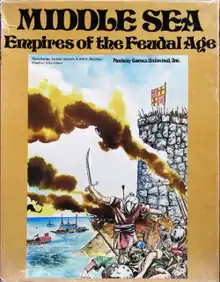Middle Sea (game)
Middle Sea, subtitled "Empires of the Feudal Age", is a board game published by Fantasy Games Unlimited (FGU) in 1979 that simulates the rise of medieval empires in the Mediterranean basin. The game started as a play by mail game before being converted into a board game.

Description
Middle Sea is a game for 2–12 players set in the Mediterranean circa 1200 where players utilize warfare, navies, economics, and diplomacy to maximize their empire. The map is divided into Christian, Muslim, and pagan provinces, and each province is ruled by a leader who can control a certain number of armies.[1]
Components
The game box contains:[2]
- 2-piece 64.5 cm x 28 cm mounted map of Mediterranean basin
- 266 die-cut counters
- 384 cards
- 16-page rule booklet
Gameplay
Each game turn represents one year and is divided into four seasons. In Spring, Summer, and Fall, armies and navies move simultaneously according to written orders; in Winter, players are confined to "at home" activities such as raising funds, and building fortifications.[2]
The purpose of the game is to invade provinces to gain access to more resources as well as the province's leader, who can then lead more armies and navies. Combat can take place on land, and also at sea if two navies occupy meet.[2]
Because of card effects; leadership, fortifications, and ships are facedown. Players can employ spies to try to find out more information about these.[1]
Publication history
Middle Sea was originally a play-by-mail game,[3] and then was converted to a board game by Wilf K. Backhaus and Terence Peter Donnelly, and published by FGU in 1979.
Reception
In Issue 33 of the British magazine Phoenix, Paul King was a bit disappointed in the quality of the components, especially the leader counters, finding that the printing was "not crisp enough for my liking." He also noted that there were no spare blank counters in case a counter was lost and no storage provided for the counters. And King found the map a bit small, considering that it was designed for up to twelve players. Given the quality of the components, King questioned the high price of the game (£13.95 in 1980). He noted the game's similarities to Diplomacy, but indicated he preferred the original game. He concluded with some ambivalence, saying, "Overall this is a good multiplayer game; however, at a cost of £13.95 I think the quality of some of the components could be improved."[2]
In Issue 32 of Dragon, James Ward thought that the game "does an excellent job of representing an era which man has been fascinated with since it happened." He thought the components were "first-rate." He concluded that "with a minimum of muss and fuss, one can play a Richard the Lionhearted or a Saladin and have a roaring good time back in an era when kingdoms could be made or broken with the strength of one good sword arm."[1]
References
- Ward, James (December 1979). "Middle Sea". Dragon. No. 32. TSR, Inc. p. 32.
- King, Paul (September–October 1981). "Middle Sea". Phoenix. No. 33. p. 30.
- "Middle Sea: Empires of the Feudal Age (1979)". boardgamegeek.com. Retrieved 2022-01-08.